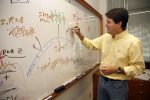
Steven F. Dowdy, Professeur à USCD, School of Medecine (La Jolla, CA) est invité par le Laboratoire des BioMolécules (LBM) du Département de Chimie de l’ENS.

Son centre principal d’intérêt de son équipe est la régulation de la progression du cycle cellulaire en phase G1 et la détermination des conséquences de ces alterations génétiques et des mécanismes qui activent cette machinerie cellulaire.
Steven Dowdy donnera, en qualité de Professeur invité au sein du LBM, les trois cours suivants :
– «Tackling a Billion Year Old Problem: Transduction of Macromolecular Peptides and Proteins into Cells», mardi 10 mai 2016, de 10h à 12h.
– «The RNA Revolution: Developing Next-Gen RNAi Therapeutics and Self-Replicating mRNAs to Generate iPS Cells», vendredi 20 mai 2016, de 10h à 12h
– «Death of a Dogma: Cyclin D, RB and Cell Cycle Control in Cancer», jeudi 26 mai 2016, de 10h à 12h.
Les cours auront lieu dans la salle 101 de l’UFR de Chimie, Barre 32-42, 1er étage (Campus Jussieu).
More important contribution :
Regulation of G1 Cell Cycle Progression in Cancer – Cell cycle progression from early G1 to late G1 and then into S phase requires both increased cellular growth, resulting in an accumulation of mass, and the concerted activities of multiple cyclin-dependent kinases (cdk), cdk inhibitors and tumor suppressors. The vast majority of malignant cells selectively target these pathways for alteration. Our lab is focused on determining the consequences of these genetic and epigenetic alterations and the mechanism that cell growth activates the cell cycle machinery. Recent work has shown that Rb is activated by mono-phosphorylation via cyclin D:cdk4/6 complexes and that cyclin E:Cdk2 complexes perform the inactivating hyper-phosphorylation of Rb at the Restriction Point. How cyclin E:Cdk2 becomes activated remains a mystery and is an extremely important question for understanding carcinogenesis as all tumors deregulate Restriction point control.
We are also interested in developing novel macromolecular delivery of RNAi therapeutics to induce synthetic lethal responses to treat cancer. Delivery across the cell membrane is restricted to uncharged, small molecules less than 500 Daltons in size. However, siRNAs are in vast excess to this bioavailability limitation and contain 40 anionic negative charges on the phosphate backbone. We set-up two nucliec acid chemistry labs and developed an entirely new field of bioreversible phosphotriester groups that neutralized the siRNA backbone, called siRNNs (RiboNucleic Neutrals). Once inside cells, intracellular thioesterases cleave off the phosphotriester groups on siRNNs to reveal a negatively charged phosphodiester backbone that is required for loading into Ago2 and induction of RNAi responses. We’ve delivered siRNNs into preclinical mouse models. Currently, we are developing Antibody-siRNN Conjugates (ARC) to target siRNNs to specific tumor types, including prostate cancer and AML, in mouse models.
We have focused a lot of our attention on delivery by protein transduction domains (PTDs)/cell penetrating peptides (CPPs), such as the TAT peptide. Our recent work has uncovered the mechanism that these peptides enter cells, namely macropinocytosis, a specialized form of fluid phase endocytosis, and devised methods to enhance endosomal escape. In addition, we have a nucleic acid chemistry group in my lab that has synthesized an entirely new class of siRNAs that we are beginning to test biologically in vitro and in vivo in metastatic models of ovarian cancer.
Steven F. Dowdy
